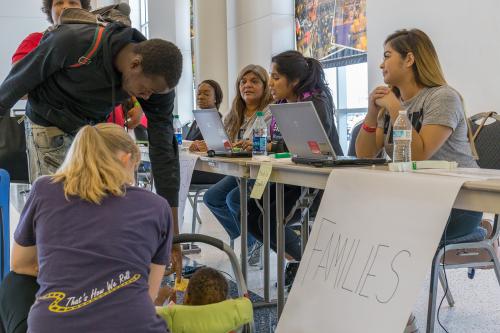Executive Summary
Chicago rebounded from four decades of population loss in the 1990s, and Census 2000 provides a snapshot of that recovery.
Chicago’s rebound derives in large part from significant immigration flows, which have made the city one of the nation’s most racially and ethnically diverse. Immigrants from Mexico now account for nearly half the city’s foreign-born population, for example, yet Chicago also remains one of the foremost U.S. gateways for workers and families from Eastern Europe. Such inflows have made Chicago more youthful, and they are responsible for the residential and commercial revitalization of many of the city’s neighborhoods. However, most new foreign-born residents are settling in the suburbs rather than the city, as they are in a number of other U.S. metropolitan areas.
Chicago made progress on income and poverty during the last decade, and all racial/ethnic groups experienced gains in homeownership. Yet in many respects the city still exemplifies our nation’s residential and economic separation by race. Blacks, Hispanics, and whites live in largely segregated neighborhoods. Annual household incomes for blacks trail those for whites by more than $20,000. And families with children face particular challenges—more than a third live below or near the poverty line, and more than one in five Chicago children live in a family with no adult workers. In the time since Census 2000 was conducted, moreover, unemployment in the city has risen, and economic differences by race and class are likely magnified today.
Along these lines and others, then, Chicago in Focus: A Profile from Census 2000 concludes that:
- Chicago’s population “rebounded” during the 1990s, but the region’s outer suburbs are booming. Census 2000 reports the story: For the first decade since the 1950s, the City of Chicago saw its population increase, by 112,000 residents. Neighborhoods on the city’s southwest and northwest sides grew rapidly with the addition of immigrant populations. At the same time, though, Chicago’s suburbs added roughly seven residents for every net new resident in the city. Most of the growth was in the outer suburbs; wide areas of suburban Cook County and inner DuPage County lost population over the decade. As a result, the economic center of the region is shifting outward. Fewer than half of the region’s workers commute to the city for their jobs, and a growing number of Chicago residents drive alone to work in the suburbs.
- The city owes much of its population growth and unrivaled diversity to new arrivals from abroad. While most Midwestern cities are home to a predominantly black/white population, Chicago boasts high racial and ethnic diversity. Whites, blacks, and Hispanics each make up at least a quarter of the city’s population. This unique mix reflects Chicago’s continued status as one of the nation’s important immigrant gateways. The city added 160,000 new residents from abroad in the 1990s. Nearly half came from Mexico, and significant numbers also came from Eastern Europe and Asia. This diversity is not uniformly dispersed, however. Chicago’s blacks and Hispanics, and blacks and whites, often live in very separate sections of the city.
- The city’s residents are relatively young, but most have lived in Chicago for several years. Baby Boomers aged 35 to 54 are by far the nation’s largest age cohorts, but people in their late 20s represent Chicago’s largest age group. But Chicago is not a transient place. The city’s youth belies the fact that nearly 85 percent of its residents have lived there for more than five years, one of the highest rates among the Living Cities. Despite a slight decline in the number of married couples with children living in the city during the 1990s, Chicago still has a higher share of these “nuclear” families than most other large cities. Whether these families remain in the city will influence Chicago’s population trajectory in the current decade.
- Chicago’s families made broad economic gains in the 1990s, though some residents—African Americans, in particular—still face hardships. Unlike many other U.S. cities in the 1990s, Chicago managed to retain its middle class, and the ranks of lower-income households declined modestly. Median household income in Chicago grew at a rate twice the national average. Poverty, especially for children, declined. Yet Chicago’s black community faces continued economic challenges. Median household income for blacks was just $29,000 in 2000, versus $37,000 for Hispanics and $49,000 for whites. Chicago has the sixth highest black poverty rate among the 23 Living Cities. The ranks of the “working poor”—families with incomes below 150 percent of poverty—are significant. Behind these economic differences lies a racial education gap; only 13 percent of black adults in Chicago hold bachelor’s degrees, compared to 42 percent of whites.
- Chicago maintains a unique mix of homeowners and renters. Forty-four percent of households in Chicago own their own homes, a rate lower than that for most large cities. Differences in homeownership between minorities and whites, however, are less stark here than in many other cities. Nearly 40 percent of racial and ethnic minority households are homeowners, and all groups—especially Hispanics—made significant gains in the 1990s. Rents rose during the decade, and median prices are similar to those in growing cities like Dallas, Phoenix, and Portland. But because Chicago’s households tend to be larger, and more likely to rent, cost burdens remain a significant issue in Chicago. To be precise, roughly 225,000 households in Chicago devote at least 30 percent of their incomes to rent.
By presenting the indicators on the following pages, Chicago in Focus: A Profile from Census 2000 seeks to give readers a better sense of where Chicago and its residents stand in relation to their peers, and how the 1990s shaped the city, its neighborhoods, and the entire Chicago region. Living Cities and the Brookings Institution Center on Urban and Metropolitan Policy hope that this information will prompt a fruitful dialogue among city and community leaders about the direction Chicago should take in the coming decade.
The Brookings Institution is committed to quality, independence, and impact.
We are supported by a diverse array of funders. In line with our values and policies, each Brookings publication represents the sole views of its author(s).


